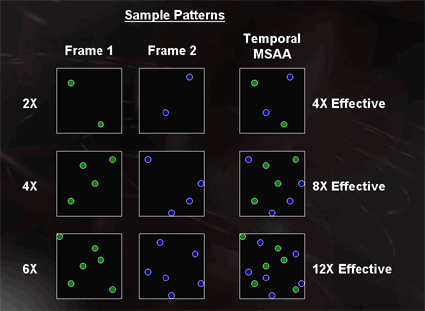ATi's X800 Pulls Off Another Coup in the Graphics Performance War
Smoothvision HD - FSAA
One of the greatest strengths of ATi's recent graphics processors has been their superb FSAA (full scene anti-aliasing) implementation. ATi's chips support sampling rates up to 6x that, in combination with the gamma correction of the color values around object borders, results in exceptional image quality. A feature that has been present since the debut of the R3xx processors, but has not been implemented thus far, is the option to use different sample patterns.
A comparison of several MSAA patterns.
With the introduction of the X800 series, ATi now finally makes use of this feature. This new technology is called "Temporal FSAA" and practically doubles the sampling rate seen on the screen.
ATi's new Temporal AA pattern
Temporal FSAA uses different sampling patterns for the odd and even frames of a scene, making them slightly different. If the frame rate is high enough, the human eye can no longer tell the frames apart. The result is that the sampling rate on the screen has been effectively doubled. The same effect is employed for TV media, which also uses interlaced half-images that alternate too quickly to be told apart.
Unfortunately, the differences between the frames cannot be seen in screenshots, since they will always either capture an odd or an even frame. You would need to capture two consecutive frames to see the effect. Using Temporal FSAA also brings some limitations with it. For one thing, V-Sync is always enabled when Temp-AA is turned on, which obviously impacts benchmark scores. For another, a minimum frame-rate limit of 60 fps is set in the driver. If the frame rate dips below this limit, Temporal AA is automatically switching to standard AA until the frame rate increases again. Without this limit, the differences between the frames would be visible to the eye at very low frame rates and would thereby actually reduce image quality instead of improving it.
The idea behind this strategy is obvious. 2xTAA offers almost the same level of quality as 4xAA while requiring only the performance of 2xAA. Temporal AA is already implemented in the X800's drivers. The feature will become available for 9x00 generation cards (with the exception of the non-DirectX 9 compatible 9000 and 9200) with an upcoming Catalyst driver release. Aside from Temporal AA, ATi hasn't changed anything about its FSAA implementation.
Get Tom's Hardware's best news and in-depth reviews, straight to your inbox.
Smoothvision HD - Anisotropic Filtering
ATi has revised the anisotropic filtering implementation for its new chip. As before, the X800 supports anisotropic filtering levels with 2, 4, 8 or 16 texture samples. Additionally, the user can choose whether the chip should apply a bilinear (Performance Mode) or a trilinear filter (Quality Mode) to the textures through the driver. Like NVIDIA's GeForce 6800 Ultra, ATi's processor can also use mixed modes that offer the best combination of image quality and acceptable performance. ATi mentions this option in its white papers but unfortunately doesn't state under what circumstances this mode is used.
| "SMOOTHVISION HD anisotropic filtering supports 2, 4, 8, or 16 texture samples per pixel. Each setting can be used in a performance mode that uses bilinear samples, or a quality mode that uses trilinear samples. There is also a new capability to support intermediate modes, to help strike the ideal balance between performance and quality." |
Current page: Smoothvision HD - FSAA
Prev Page 3Dc Normal Map Compression Next Page Power Consumption


